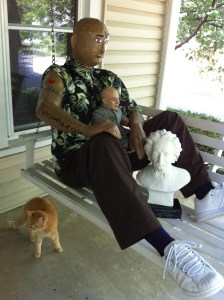NOAA Teacher at Sea
Melissa George
Aboard NOAA Ship Oscar Dyson
July 22–August 9, 2013
Mission: Alaska Pollock Survey
Geographical Area of Cruise: Gulf of Alaska
Date: July 20, 2013
Introductory Blog
Greetings from Lafayette, Indiana, where I recently moved back after spending two years in Washington, D.C. as an Albert Einstein Distinguished Educator Fellow at the National Science Foundation in the Division of Environmental Biology. In my recent position, I learned of many of the interesting research projects that ecosystem ecologists, population and community ecologists, systematic biologists, and evolutionary biologists are working on in various parts of the world. Beginning this fall, I will be returning to the Lafayette School Corporation to teach Biology and Zoology at Jefferson High School in Lafayette, Indiana. I am excited to integrate aspects of the research I have learned about into my classroom.
Enhancing my understanding will be the authentic research experience in the Gulf of Alaska as a NOAA Teacher at Sea. I will fly to Kodiak Island and board NOAA Ship Oscar Dyson, a support platform to study and monitor various aspects of the ocean: environmental conditions, habitat assessments, and marine mammal, fish, and bird populations.

This particular mission will be surveying the population of a species of fish called Alaskan pollock or scientifically speaking, Theragra chalcogramma. These fish belong to the cod family and are one of the United States’ most valuable fisheries; they are typically sold as fish sticks, fish patties, or imitation crab, scallops, or shrimp. Pollock populations vary from year to year, thus fish surveys, help to enact management practices as well as monitor the effects of climate change.

This adventure is exciting to me for several reasons. First, growing up on the Pacific Coast in Santa Cruz, California I fell in love with the ocean at a young age. I realize the importance of respecting the ocean and the ecosystems within it and around it. Having spent the second half of my life in the Midwest, I have missed its calming effect as well as the wealth of ecological wonders it holds. I escape to the ocean whenever I have the chance. Below is a picture of me resting on the beach at Halawa Bay on the east end of Molokai, one of the Hawaiian Islands.

Second, I hope to incorporate what I learn about how ocean scientists monitor various animal populations into my high school classes. There are so many aspects to this endeavor, I think my students will be excited to learn about many, if not all, of them.
Fun Fact:
I have four traveling companions. They are in the photo below. One of them will be accompanying me on the Teacher at Sea mission. See if you can find pictures of this traveling companion in future posts and please comment when you do!


